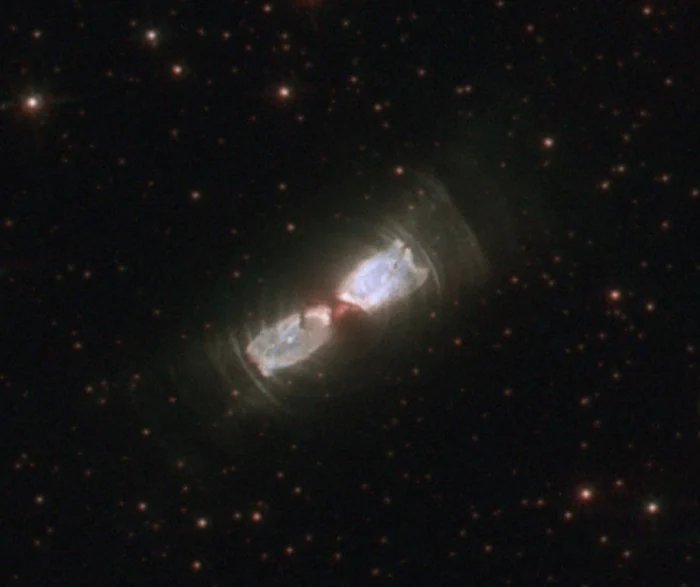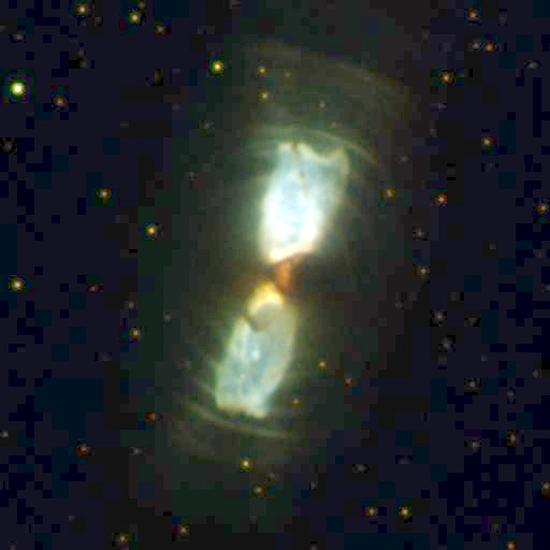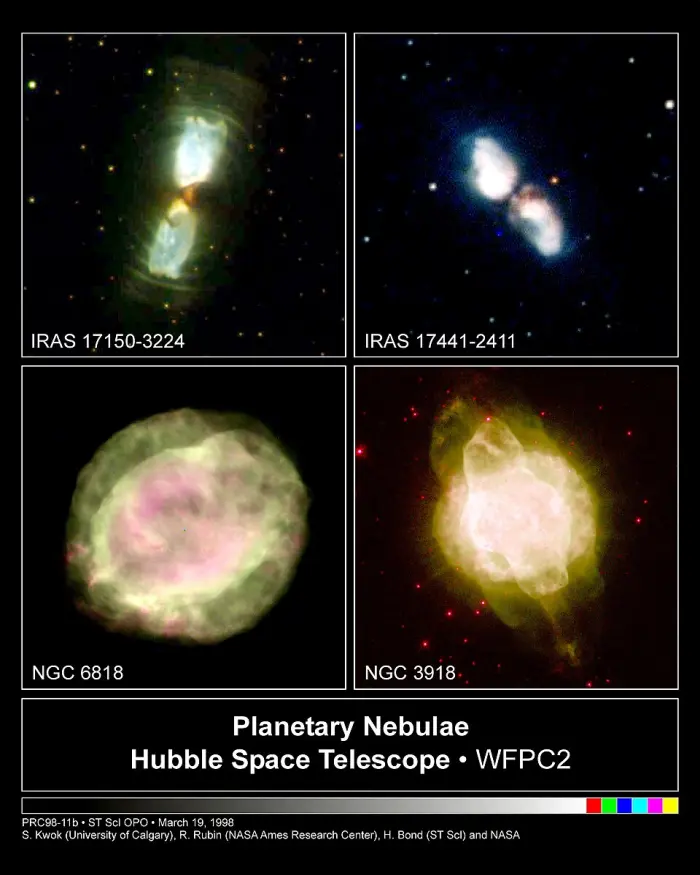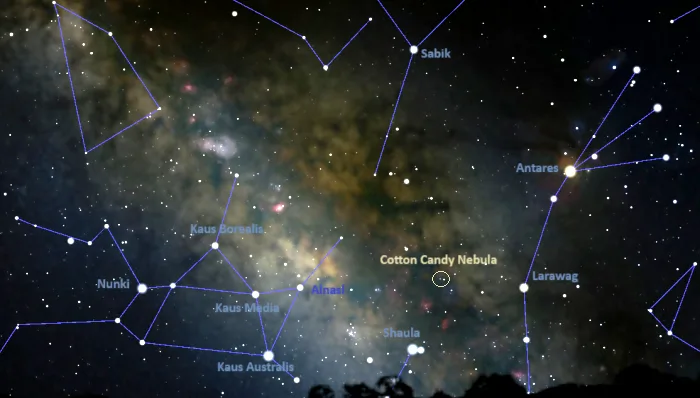The Cotton Candy Nebula (IRAS 17150-3224) is a protoplanetary nebula located in the southern constellation Scorpius. With an apparent size of only 16 arcseconds, it cannot be observed in small and medium telescopes. It appears almost edge-on from our point of view.
Located in the rich field of the southern Milky Way, the Cotton Candy Nebula was unknown to astronomers before the 1980s. It appears in a region of the sky rich with brighter nebulae and star clusters.
Like all preplanetary nebulae, the cosmic Cotton Candy was produced by a post-AGB star, an evolved red giant that reached the final stages of its life cycle. The nebula is composed of material lost from the star in the late asymptotic giant branch (LAGB) phase.

Cotton Candy Nebula, image credit: Judy Schmidt (CC BY 2.0)
Preplanetary nebulae are short-lived transitional objects between the asymptotic giant branch (AGB) and planetary nebula phases. Produced by post-AGB stars, these objects are reflection nebulae and emit strongly in the infrared. During the LAGB stage, the stars become unstable, and the mass of their hydrogen envelopes is significantly reduced. When the gaseous envelope is completely lost, the temperature of the central star is around 5,000 K and the protoplanetary nebula phase begins.
During this phase, the effective temperature of the star gradually rises, but the central stellar remnant is still not hot enough to ionize the surrounding clouds of material and produce an emission nebula. Instead, the nebula only reflects the central star’s light. It is shaped by the star’s high-velocity winds, which collide with the slower moving material expelled from the star.
The preplanetary nebula phase ends when the star’s temperature reaches around 30,000 K. At this point, the star can produce enough ultraviolet radiation to ionize the expanding shell and make it emit its own light. The nebula becomes an emission nebula and evolves from a protoplanetary into a planetary nebula.
The central star of the Cotton Candy Nebula is completely hidden behind an optically thick dusty torus. The thick shell absorbs almost all the star’s light and re-emits it in the infrared. In 1993, astronomers suggested a spectral type of G2 I for the star.
The Cotton Candy Nebula is an example of a DUPLEX-type (DUst-Prominent Longitudinally-EXtended) protoplanetary nebula, which is a precursor to a bipolar planetary nebula. DUPLEX protoplanetary nebulae have prominent bipolar reflection nebulae with pinched waists and heavily obscured central stars. The Red Rectangle Nebula in the constellation Monoceros is another well-known example.
Unlike Star-Obvious Low-level-Elongated (SOLE) nebulae, which have prominent central stars surrounded by faint elliptical or multi-lobed nebulae, DUPLEX-type protoplanetary nebulae are produced by more massive stars and have much stronger stellar winds.
In 2002, a team of astronomers estimated a distance of 3.6 kiloparsecs (11,741 light-years) for the Cotton Candy Nebula. However, the nebula’s exact distance is not well known. The team also found a total mass of 14 solar masses for the circumstellar shell of the central star, which is much higher than expected for a progenitor of a planetary nebula. Astronomers have proposed that the star left the asymptotic giant branch only 210 years ago.
In 2022, a team of astronomers led by Katherin Gold, University of Arizona, examined the molecular content in the Cotton Candy Nebula, the Footprint Nebula (M1-92) in Cygnus, and IRAS 22036+5306 in Cepheus using the 12-meter antenna and the Sub-millimeter Telescope (SMT) of the Arizona Radio Observatory (ARO) and the IRAM 30-metre telescope on Pico Veleta in Spain. All three protoplanetary nebulae were found to contain carbon-bearing molecules and prominent lines of sulfur. The Cotton Candy Nebula also contains the cyanides CN, HCN (hydrogen cyanide), and HNC (hydrogen isocyanide).

The Cotton Candy Nebula captured by the Hubble Space Telescope’s Wide Field and Planetary Camera 2, credit: Sun Kwok and Kate Su (University of Calgary), Bruce Hrivnak (Valparaiso University), and NASA/ESA (PD)
Facts
The Cotton Candy Nebula was discovered by the IRAS satellite (Infrared Astronomical Satellite) in the 1980s. Bruce Hrivnak of the Valparaiso University and Sun Kwok and Kevin Volk of the University of Calgary searched through the IRAS catalogue for protoplanetary nebula candidates. Once they identified them, they looked for their visual counterparts with the Canada-France-Hawaii Telescope (CFHT) and the United Kingdom Infrared Telescope on Mauna Kea, Hawaii, and the 4-metre telescope at the Cerro Tololo Inter-American Observatory in northern Chile.
The astronomers discovered the nebula and named it the Cotton Candy. They are also credited for naming the Water Lily Nebula (IRAS 16594-4656) in the constellation Ara, the Silkworm Nebula (IRAS 17441-2411) in Sagittarius, and the Walnut Nebula (IRAS 17245-3951) in Scorpius.
The Cotton Candy Nebula was first proposed as a protoplanetary nebula candidate by van der Veen et al. and Volk & Kwok in 1989 based on its infrared colours.
In 1991, imaging with the Canada-France-Hawaii Telescope revealed nebulosities around the central stars of the Cotton Candy Nebula and the Silkworm Nebula (IRAS 17441-2411). The nebulae were found to contain cocoons roughly spherical in shape, produced by stars in the red giant stage of evolution. Both nebulae appear similar to the better-known Egg Nebula (IRAS R21003+3629) in Cygnus, the first preplanetary nebula discovered.
In 1993, both nebulae were imaged by the Wide Field and Planetary Camera 2 (WFPC2) aboard the Hubble Space Telescope (HST). The Hubble images revealed a series of concentric rings of material ejected by the central stars in the final several thousand years of their lives. The Cotton Candy was revealed to be a bipolar nebula.

The Cotton Candy Nebula, the Silkworm Nebula, the Little Gem Nebula and the Blue Planetary Nebula (the Southerner). The nebulae are being illuminated by light from the invisible central star, which is then reflected toward us. We are viewing the nebulae edge-on, where the direct starlight is blocked by the dusty cocoon. Otherwise, the starlight would overwhelm the nebular light, making it very difficult to see the butterfly-shaped nebula. In a few hundred years, intense ultraviolet radiation from the central star will energize the surrounding gas, causing it to glow brightly, and a planetary nebula is born. Image credit: S. Kwok (University of Calgary), R. Rubin (NASA/ESA Ames Research Center), H. Bond (ST ScI) and NASA/ESA (CC BY 4.0)
Location
The Cotton Candy Nebula appears in the region above the Scorpion’s stinger, about a quarter of the way from Larawag (Epsilon Scorpii) to Kaus Borealis (Lambda Sagittarii). Larawag is part of the Fish Hook of Scorpius and Kaus Borealis forms the Teapot with other bright stars in Sagittarius.
The Cotton Candy Nebula lies north of the Cat’s Paw Nebula (NGC 6334), northwest of the Lobster Nebula (NGC 6357), and west of the Butterfly Cluster (Messier 6). It can be spotted in 16-inch and larger telescopes.
The best time of the year to observe deep sky objects in the constellation Scorpius is during the month of July, when the celestial Scorpion appears higher above the horizon in the early evening.

Location of the Cotton Candy Nebula, image: Stellarium
Cotton Candy Nebula – IRAS 17150-3224
| Constellation | Scorpius |
| Object type | Protoplanetary nebula |
| Right ascension | 17h 18m 19.8040606320s |
| Declination | −32° 27′ 21.547417932″ |
| Apparent size | 15″.9 x 8″.7 (visible); 15″.2 x 8″.4 (infrared) |
| Names and designations | Cotton Candy Nebula, IRAS 17150-3224, PN G353.8+02.9, RAFGL 6815S, SCHB 11, 2MASS J17181985-3227216, OH 353.84+02.98, OH 353.844+02.984, DENIS J171819.8-322721, GLMP 540, GSC2 S222330241876, TIC 153805183, [LFO93] 1715-32, [TCH91] 17150-3224, MSX5C G353.8435+02.9837, MSX6C G353.8435+02.9843, WISE J171819.87-322721.7, Gaia DR2 5979492330361622912, Gaia DR3 5979492330361622912 |